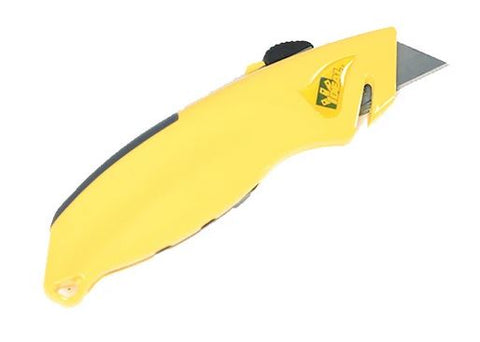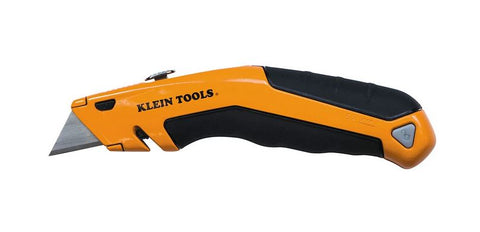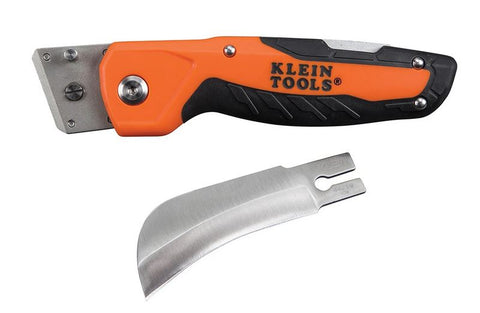History of Utility Knives and How They've Changed
All knives are utility knives in a manner of speaking in that they are designed to do a job of some sort. However, as knives have become more specialized, utility knives have come to be defined as a very specific style of barebones knife often for small cutting jobs. Utility knives are usually understood to be basically a handle that has a small razorblade type blade retracted into it and the blade comes out usually with a small switch. Some utility knives have a flip out option, but in both cases the blade of the knife is small and replaceable. Although some style of utility knife goes back to Roman times, possibly even prehistoric times (or more recently the pen knife depending on your definition of utility knife) the first modern style utility knife is widely acknowledged to have been made by Stanley in 1936. This utility knife did not feature a retractable blade, however it was a replaceable blade which may have been a first. It had the same basic shape as most utility knives, namely that of a handle with a small blade, setting it apart from a conventional knife. It’s possible that this was inspired by fur knives like this 1926 model though with obvious differences and a better handle. A good overview on the history of utility knives with plenty of visuals (and bandages) can be seen here and you can see a 1963 update of Stanley’s original design which featured what’s acknowledged as the first retractable blade. Many toolmakers imitated Stanley’s designs making them the driving force of innovation in the early days, although other innovations did pop up on occasion. This led to several styles of knife and there are now just these few styles of utility knife that have become more or less standard.
The standard for a very long time was the basic retractable utility knife. This design is pretty much foolproof. You push a button to slide the blade out when you need it and push it back when you don’t. While there have been some changes along the way, this style has gone largely unchanged – the biggest changes being the addition of features. Ideal’s 35-300 utility knife is a good example of this style, but they’ve added a storage compartment for extra blades and there’s a “pull-line” cutter allowing you to cut the tape on boxes, carpet, small wires, zip ties and twine without even taking the blade out. Greenlee’s 0652-11 Utility knife is similar but allows blade changing from the front with the push of a button. Klein’s 44136 removes the storage, but adds rubber grips and a self-retracting blade that you can lock into place. Klein’s 44133 has the same features but adds a few more by adding the “Klein-Kurve” to the handle and adds blade storage. These utility knives are a reliable standard you can use for basic cutting on virtually any job.
Although those utility knives are excellent tools, there are options that are a bit less clunky and combine the best features of a folding pocket knife with the versatility of your normal utility knife. Most of these styles feature a belt clip as well as easily replaceable blades. Feel free to correct us, but the earliest example of this folding utility knife appears to have been invented by Robert E. Scarla in 2002, though it’s not clear if this was made for a specific manufacturer. We’d love to know, so share if you can! There have been many variations on this basic design. Klein Tools has at least three. Klein 44130 adds a couple of extra features namely retractable blades and a quick release to allow quick blade changes. Klein’s 44131 locks the blade in place when not in use for added safety and is meant for a little more heavy-duty work and has a notch for wire stripping. Klein’s 44135 is overall similar to the 44130 except for the camouflage design and the ability to lock the blade when closed for safety. We also carry Hazet’s 2157-2 mini utility knife which is of a similar design but small enough to carry on a keychain. It comes with five spare blades and a quick release lever for closing the blade. Lastly, the Greenlee 0652-22 folding utility knife is of this design as well and allows quick blade changing and blade storage. These folding utility blades are sleek and easy to carry around meaning you can always have a blade for cutting. Replacement blades for the larger models are also available in 5 packs (Klein and Greenlee) and even a 50 pack made by Klein. If any design is better than the original, this folding utility knife would probably be it.
The last style of utility knife is the Hawkbill knife, sometimes referred to as a pruner. While it does stretch the definitions of a utility knife, it is a knife pretty much dedicated to utilitarian use. There’s very little history about hawkbills that’s widely known, though it’s pretty much undisputed that the blade style originated in agriculture. Now it’s primarily used for stripping wires and also for cutting linoleum, sacks, zip ties and many more objects. The oldest and most common example would probably be the scythe. The scythe and the hawkbill blade work by having the cutting edge on the inside of the curve allowing you to use the whole blade for cutting which also makes it easier. While most hawkbill knives should be essentially the same, there are many varieties and we carry hawkbills made by Greenlee Tools and Klein Tools. At present we have 12 different styles, some with fixed blade like this Greenlee and many more that are foldable. There is also an option to get a hawkbill with a rounded tip. As well as just replacement hawkbill blades. Hawkbill knives are a really great hand tool and make a great choice if you need something a little tougher than a normal utility knife.
Utility knives have been around for centuries and for the last century or so they’ve become more compact and specialized for unique jobs. Throughout the past century utility knives have proven their usefulness to the point where life without them would be vastly different. From grocers and anyone breaking down cardboard to electricians and everything in between, utility knives are here to stay. To quote the “$5 Knife Guy” from downtown Los Angeles, “put a knife in your life.” It’ll be more than $5, but you’ll be getting a well-made tool that you can keep with you for many years.







Leave a comment